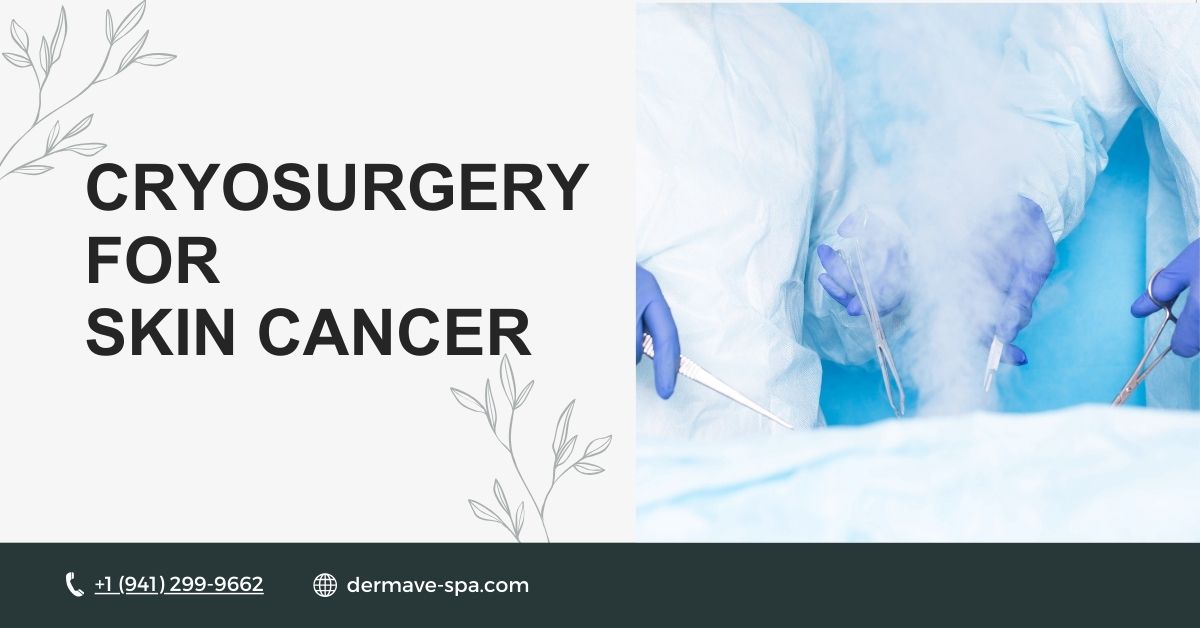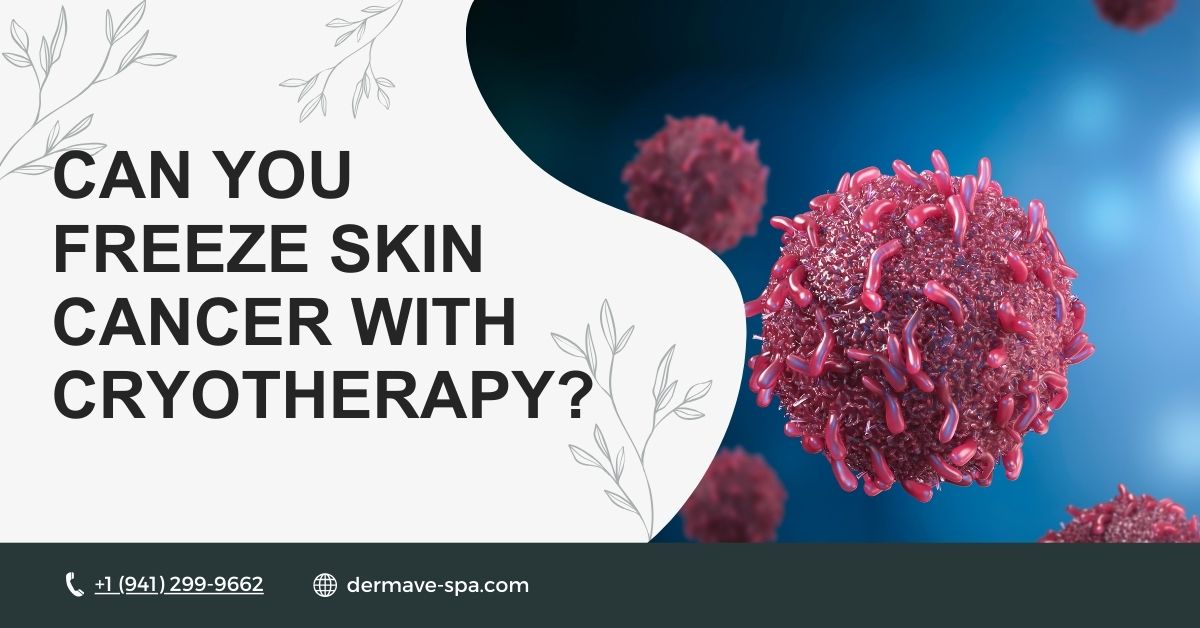Cryotherapy, a procedure that uses extreme cold to freeze and destroy abnormal skin cells, has emerged as a viable treatment option for various skin conditions, including precancerous lesions and skin cancer. This technique, often performed in a clinical setting by a dermatologist or specialized healthcare team, utilizes liquid nitrogen to treat affected areas.
Patients may wonder about the effectiveness and safety of cryotherapy for conditions like actinic keratoses, basal cell carcinomas, and squamous cell carcinomas. In this article, we will explore when cryotherapy may be a suitable option and delve into its applications in treating skin cancer.
When is Cryotherapy a Treatment Option for Precancerous Skin Conditions?
Cryotherapy is frequently used to treat precancerous skin conditions, such as actinic keratoses, which can lead to skin cancer if left untreated. During this procedure, a doctor applies liquid nitrogen directly onto the lesion using a cotton swab or spray, effectively freezing the abnormal cells. Patients can expect some level of pain, often described as a burning sensation, that lasts only a few minutes.
After treatment, the targeted area may blister, leading to a crust that eventually heals over a week. Proper care of the wound is essential to minimize risks such as infection or prolonged redness. Dermatologists usually recommend follow-up visits to monitor the treated site and assess the healing process.
Cryosurgery for Skin Cancer

Cryosurgery is an effective method used to treat skin cancer, particularly for superficial basal cell carcinomas and squamous cell carcinomas. By applying extreme cold to the cancerous tissue, the procedure leads to the destruction of the targeted cells while sparing the surrounding healthy skin. The recovery time varies among patients; some may experience redness and swelling, while others might develop a scab that falls off within a week.
It’s crucial for patients to consult with their healthcare provider to determine if cryosurgery is the best choice for their specific condition. In many cases, the success rate of this minimally invasive treatment is high, making it a favored option for many dermatology patients.
What You Should Know About Cryosurgery for Skin Cancer?
Cryosurgery, also referred to as cryotherapy, is a specialized procedure that employs extreme cold to treat skin cancer effectively. This method is often used to target superficial lesions such as basal cell carcinomas and squamous cell carcinomas. The process typically involves the application of liquid nitrogen directly onto the skin, which freezes and destroys the cancerous tissue while minimizing damage to the surrounding healthy cells.
However, it’s crucial to consult your doctor about exercise after cryotherapy. Patients may expect a brief discomfort during the application, often described as a burning sensation. The treatment is generally quick, usually taking only a few minutes, and can often be performed in a clinical setting by a dermatologist or a specialized healthcare team. Understanding the procedure and its implications can help patients make informed choices regarding their treatment options.
Possible risks
While cryosurgery is a minimally invasive treatment option for skin cancer, it is not without risks. Some potential side effects may include redness, swelling, and blistering at the treated site. In certain cases, patients may experience prolonged pain or bleeding, particularly if proper care is not taken during the healing process.
It is essential to monitor the wound closely for any signs of infection, such as increased redness or pus formation. Though these side effects are usually temporary and resolve within a week, they can vary from patient to patient. Consulting with a healthcare provider before undergoing cryotherapy can help individuals understand these risks and prepare adequately for their treatment.
Side Effects of Cryotherapy for Precancerous Skin Conditions
When cryotherapy, which is also known as cryofreeze, is used to treat precancerous skin conditions like actinic keratoses, patients may encounter specific side effects. Common reactions include blister formation and the development of a crust over the treated area, which are normal parts of the healing process. Patients may feel some pain or discomfort during the procedure and for a short period afterward.
It’s crucial to follow post-treatment care instructions to promote healing and reduce the risk of complications. While most side effects are mild and resolve within a week, some patients may experience more significant reactions, necessitating a follow-up visit to assess the condition of the skin and ensure proper recovery.
Why Choose Cryosurgery for Skin Cancer?
Cryosurgery is increasingly becoming a preferred treatment option for skin cancer due to its effectiveness and minimally invasive nature. Patients appreciate its ability to target and freeze cancerous cells without extensive surgery, leading to quicker recovery times compared to traditional surgical methods. The procedure can be performed in an outpatient setting, allowing patients to return home shortly after treatment.
Additionally, the high success rate of cryotherapy, particularly for superficial skin cancers, makes it an appealing choice for many individuals. By discussing all available options with their healthcare team, patients can determine if cryotherapy is the right fit for their specific skin condition and overall health needs.
What to Expect After the Procedure?
After undergoing cryotherapy, patients can expect a range of reactions in the treated area. Initially, there may be a burning sensation during the application of liquid nitrogen, followed by immediate redness and swelling. Within a few days, a blister may form, which is a normal part of the healing process as the skin begins to repair itself. Patients should anticipate a crust or scab developing over the site, which typically falls off within a week.
It’s essential to clean the wound regularly and keep it dry to promote healing and reduce the risk of infection. Following the procedure, monitoring the area for any unusual symptoms is crucial, and patients should feel comfortable reaching out to their healthcare provider if concerns arise.
How to Prepare for the Procedure?

Preparing for cryotherapy involves several important steps to ensure the best possible outcome. Patients should have a thorough consultation with their dermatologist or healthcare team to discuss their medical history and any medications they are currently taking. It’s advisable to avoid blood-thinning medications, as they may increase the risk of bleeding during and after the procedure.
On the day of treatment, patients should arrive with clean skin, free of lotions or oils, to facilitate the effective application of liquid nitrogen. Wearing loose-fitting clothing can also help the procedure go smoothly. Being mentally prepared for the brief discomfort and understanding the post-care instructions will enable patients to navigate the experience with confidence.
Skin Healing After Cryotherapy
The healing process after cryotherapy varies from patient to patient, but there are general expectations to keep in mind. As the skin begins to heal, it’s common for a blister to form in the treated area, which will eventually crust over. This crusting is part of a natural healing response as the body works to replace the frozen tissue with healthy skin.
Patients may notice redness and swelling for several days, but these symptoms should gradually subside. It’s important to avoid picking at the scab or crust, as this can lead to scarring or infection. Following proper aftercare, including keeping the area clean and dry, will support optimal healing and minimize complications.
Advantages of Cryotherapy Over Other Skin Treatments?
Cryotherapy offers several advantages compared to traditional skin treatments for cancer and precancerous conditions. One of the primary benefits is its minimally invasive nature, which means less pain and a quicker recovery time than surgical alternatives. Unlike excisional surgery, cryotherapy does not require incisions, making it a more comfortable option for many patients.
Additionally, the use of liquid nitrogen allows for precise targeting of abnormal skin cells while sparing healthy tissue, which can lead to better cosmetic outcomes. Many patients appreciate the convenience of having the treatment performed in an outpatient setting, allowing them to return home shortly after the procedure. These factors contribute to the growing preference for cryotherapy among dermatology patients seeking effective skin cancer treatments.

